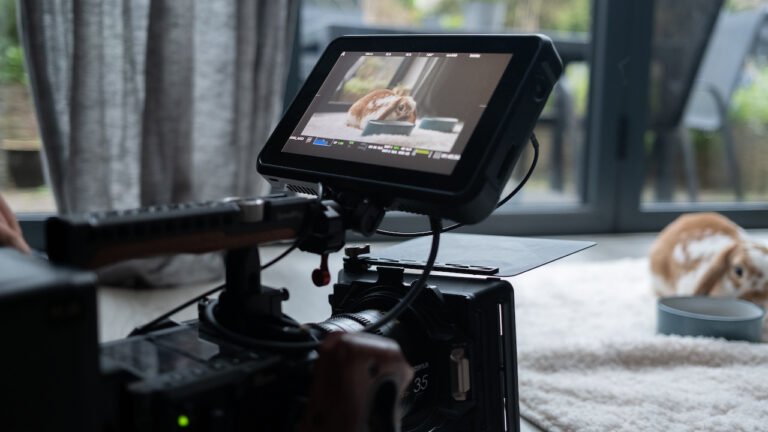When you’re crafting a compelling editorial video, it’s crucial to focus on several key elements that will keep your audience engaged from start to finish. You need an engaging script that captivates the viewer and visual storytelling that employs dynamic imagery and cohesive themes. A strong opening hook is important to grab attention immediately. High-quality production values, including clear visuals and audio, cannot be overlooked either. Emotional connections foster empathy through relatable narratives, while a clear call-to-action guides your audience’s responses. But how do you guarantee your video truly resonates with your target audience?
Key Takeaways
– Engaging Scriptwriting: A strong narrative structure with clear, concise language and an attention-grabbing introduction captivates the audience.
– Visual Storytelling: Cohesive imagery and dynamic shots aligned with the story’s theme enhance viewer interest and comprehension.
– Emotional Connection: Relatable storytelling, complemented by visuals and music, builds empathy and resonates with audience experiences.
– High-Quality Production: Professional equipment, sound quality, and detailed editing ensure clear visuals and a polished, professional touch.
– Clear Call-to-Action: Direct, compelling statements guide viewer actions, emphasising benefits and creating urgency to increase engagement.
Engaging Scriptwriting
Crafting an engaging script is the backbone of any compelling editorial video. To captivate your audience, focus on creating a strong narrative structure. Begin with an attention-grabbing introduction that sets the stage for your story. You want to establish a clear, consistent flow that guides viewers through your content seamlessly. Each segment should logically lead to the next, maintaining a coherent storyline.
Don’t underestimate the power of tone variation. The tone of your script should fluctuate to match the emotions you want to evoke. Whether it’s excitement, curiosity, or concern, varying your tone keeps viewers emotionally invested. Use a friendly, conversational tone to make your content relatable, but adjust it to suit different parts of your narrative.
Additionally, make sure your script is concise and to the point. Avoid unnecessary jargon or filler words. Every sentence should serve a purpose, either advancing the storyline or emphasising key points.
Visual Storytelling
Visual storytelling breathes life into your editorial video, transforming your script’s words into vivid, memorable images. It helps you convey complex ideas in a way that resonates emotionally with your audience.
By using visual metaphors and a strong narrative structure, you create a more immersive experience that keeps viewers engaged from start to finish.
To enhance your visual storytelling, consider these elements:
– Visual Metaphors: Use imagery to symbolise your key messages. For instance, a blooming flower to represent growth or a bridge to signify connection.
– Narrative Structure: Craft a clear beginning, middle, and end in your video. This structure guides your audience through the story seamlessly.
– Cohesive Imagery: Ascertain that all visual elements align with your story’s theme. This not only reinforces your message but also creates a visually appealing video.
– Dynamic Shots: Vary your camera angles, movements, and compositions to maintain visual interest. Dynamic shots can evoke different emotions and keep the audience intrigued.
– Consistent Branding: Use your brand’s colours, fonts, and logos consistently. This makes your video recognisable and reinforces your brand identity.
Visual storytelling isn’t just about pretty pictures; it’s about weaving a visual narrative that amplifies your message and leaves a lasting impact.
Strong Opening Hook
A strong opening hook grabs your audience’s attention from the very first frame, setting the tone for the rest of your editorial video. Think of it as your golden opportunity to make a memorable first impression. You want to start with something that sparks curiosity or evokes emotion.
Use unique perspectives to distinguish your video from the countless others out there. Whether it’s a compelling question, a surprising fact, or a bold statement, make certain it resonates with your viewers.
Your opening should also establish audience relatability. Show them that you understand their interests or concerns. You might start with a scenario they frequently encounter or a problem they’re keen to solve. When your audience feels seen and understood, they’re more likely to stay engaged.
Additionally, keep the opening concise. An overly long introduction can lose your audience before the real content even begins. Aim for a clear, punchy delivery that promises value right away.
High-Quality Production
High-quality production is essential to making your editorial video not only watchable but also memorable. When you invest in professional equipment and utilise advanced post production techniques, your video stands out from the crowd.
It’s all about guaranteeing every visual and audio element aligns perfectly to captivate your audience.
To achieve high-quality production, focus on the following:
– Professional Equipment: Invest in high-grade cameras, microphones, and lighting. This guarantees your footage is clear, your audio is crisp, and your visuals are well-lit.
– Sound Quality: Clear, high-quality audio is vital. Poor sound can detract from even the most compelling visuals.
– Editing Software: Use industry-standard editing software to refine your footage. This allows you to cut unnecessary scenes and enhance the overall flow.
– Colour Grading: Applying colour grading during post production can markedly enhance the aesthetic of your video, making it more visually appealing.
– Attention to Detail: Small details like changes, effects, and graphics can add a polished, professional touch to your video.
Emotional Connection
Crafting an emotional connection with your audience is essential to making your editorial video resonate on a deeper level. When viewers feel emotionally engaged, they’re more likely to share, comment, and remember your content.
To achieve this, employ storytelling techniques that evoke strong emotions. Start by telling a relatable story that mirrors your audience’s experiences or challenges. This helps build viewer empathy, making them feel understood and connected to your message.
Use visuals and music that complement the emotional tone you aim to convey. A heartfelt soundtrack or poignant imagery can amplify the emotional impact. Remember, authenticity is key. Your audience can easily spot insincerity, so guarantee your content aligns with genuine emotions and real-life scenarios.
Incorporate personal anecdotes or testimonials to add a human touch. Hearing a real person share their story can be incredibly powerful and relatable.
Keep your narrative focused and concise, avoiding unnecessary details that could dilute the emotional impact.
Lastly, use pacing strategically. Slow down during emotional peaks to allow viewers to fully absorb the moment.
Clear Call-to-Action
To maximise the impact of your editorial video, it’s crucial to include a clear call-to-action (CTA). A compelling CTA serves as the bridge between your content and the viewer’s next steps, making your messaging more effective.
Without it, even the most engaging video can fall short in driving viewer motivation to act.
When crafting your CTA, consider the following elements:
– Be Direct: Clearly state what you want the viewer to do next. Ambiguity can reduce the likelihood of action.
– Use Strong Verbs: Words like “discover,” “join,” “subscribe,” or “share” can energise viewers and prompt immediate action.
– Highlight Benefits: Let viewers know what’s in it for them. Effective messaging connects your CTA to tangible benefits or outcomes.
– Create Urgency: Phrases like “limited time,” “today only,” or “don’t miss out” can heighten viewer motivation by adding a sense of urgency.
– Keep It Simple: A concise CTA is easier to follow. Overloading viewers with too many steps can be overwhelming.
Integrating these elements into your editorial video can greatly enhance its effectiveness. A clear, compelling CTA guarantees that your message resonates and that viewers are motivated to take the desired action.
Audience Targeting
Understanding your audience is the foundation of creating a compelling editorial video. You can’t craft a message that resonates if you don’t know who you’re speaking to. Start with demographic analysis to pinpoint the age, gender, income, and education level of your target viewers. This data helps you tailor content that speaks directly to their needs and interests.
Next, explore creating detailed audience personas. These fictional characters represent your ideal viewers, based on real data and insights. Think about their hobbies, challenges, and preferences. Are they young professionals juggling multiple responsibilities, or retirees seeking new hobbies? By defining these personas, you’ll be able to address their specific pain points and desires more effectively.
Don’t stop there. Continuously engage with your audience through comments, surveys, and social media interactions. This ongoing dialogue will refine your understanding and keep your content relevant.
Frequently Asked Questions
How Do You Choose the Right Platform for Your Editorial Video?
Think of your video as a seed. To make it bloom, consider your audience demographics and platform features. Choose a platform where your audience thrives and the features align with your content’s needs.
What Are the Best Practices for Optimising Video Length?
To optimise video length, focus on audience attention and content pacing. Keep videos concise, around 2-3 minutes, ensuring the content flows smoothly. Avoid dragging; trim unnecessary parts to maintain engagement and deliver your message effectively.
How Can You Effectively Use Music in Editorial Videos?
You can effectively use music in editorial videos by focusing on music selection that complements your content. Choose tracks that enhance the emotional impact, creating a stronger connection with your audience and driving your message home.
What Metrics Should You Track to Measure a Video’s Success?
To measure a video’s success, keep an eagle eye on engagement rate and audience retention. They reveal if viewers are hooked and how long they stay. These metrics will help you understand and improve your content’s impact.
How Can You Repurpose Editorial Videos for Different Formats?
To repurpose editorial videos for different formats, you should focus on content adaptation. Edit the video to fit various platforms’ requirements, such as aspect ratios, length, and style. Tailor your message to each specific audience.
Conclusion
You’ve got it now! Crafting a compelling editorial video? It’s practically an art form. Nail that script writing like Shakespeare, make your visuals Picasso-level, and hook your audience from the first second. Think Hollywood production quality, with audio so crisp and visuals so clear, they’ll feel like they’re living it. Stir emotions like a symphony, and don’t forget that crystal-clear call-to-action. Know your audience inside out, and you’ll have them eating out of the palm of your hand!






